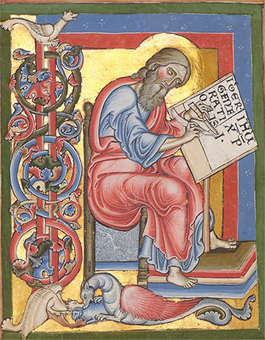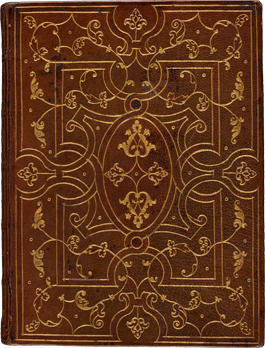An Empire of Book Art
John Haberin New York City
Imperial Splendor and the Wrightsman Collection
As an old joke has it, the Holy Roman Empire was neither holy, Roman, nor an empire. That did not, though, prevent it from spanning centuries and central Europe. With "Imperial Splendor," the Morgan Library leaves no doubt about its splendors and influence.
That joke may have gone stale, but the Morgan could only agree with it. It would count, in fact, as high praise and the realm's greatest achievement. It might not have been holy, but only because it was a center of reform from the very start, after Charlemagne, then king of the Franks, became emperor in the year 800. It might not have been Roman, but only because it grew after the fall of Rome from a loose association of Germanic tribes to extend across Bavaria and to new urban and intellectual centers in Prague and Vienna. It might not have been an empire,  but only because it accommodated the growing power of the pope and the aristocracy. For a monk toiling over manuscripts in the early 900s or an artist like Albrecht Dürer in the late fifteenth century, it was the place to be.
but only because it accommodated the growing power of the pope and the aristocracy. For a monk toiling over manuscripts in the early 900s or an artist like Albrecht Dürer in the late fifteenth century, it was the place to be.
After nine centuries of the Holy Roman Empire, it is only fair to ask: what about the other half of Europe, and what came next? Also at the Morgan, France before the revolution had its own claims to rare books and imperial splendor, and does their collector. More than two years after her death at age ninety-nine, Jayne Wrightsman still presides over her collection of rare and lavish bound books. In a photo for Vogue, enlarged for a wall, she commands her apartment across from Central Park—and every last bit of your attention. She poses on a Louis XV cut-velvet sofa, in a Givenchy satin gown, without a book in sight.
You can, of course, always look around you for quite a show of Moroccan leather and its contents, if only you can turn away. In the photo, she welcomes you with a lavish display of flowers and a table of snuff boxes—but at a distance and not, to be sure, for your choice of snuff. She sits beneath a painting by Pierre-Auguste Renoir, of a girl with a cat rising on its hind legs for another perfect performance. You can only imagine the apartment's one hundred feet of frontage on Fifth Avenue. Is this a show of precious books or of an American royalty? For the Morgan, it is "Bound for Versailles."
A decentralized empire
The curators, Joshua O'Driscoll and Jeffrey F. Hamburger, call the Holy Roman Empire "a diverse, multiethnic, and highly decentralized confederation of states and jurisdictions, loosely allied under an elective, rather than hereditary, monarchy." That makes it sound quite modern, and they also speak of "networks," as in corporate or computer networking. The show runs counter to traditional views of a rebirth after 1400, not in stuffy old Germany, but with the Northern Renaissance and the Renaissance in Italy. At the Morgan, the Carolingian empire already looks like anything but the Dark Ages. In illuminated manuscripts, the Gospel writers have ample space for their robes and books in a makeshift perspective. With the Ottonian empire, under Otto I after 962, things only get better.
Books here are ritual objects, for instruction and prayer, with elaborate bindings to match. Within, their gilding extends to gold backgrounds and, with the Golden Gospels from around 980, gold letters on purple-stained pages. With the Lindau Gospels around 890, pages become simulated textiles, on top of the jeweled covers in low relief. Still, monasteries then were "scriptoriums," where pages often displayed the Gospel writers pen in hand, page still unfinished, and the name of the game was text. It seems only a short step to the dense text of the Gutenberg Bible soon after 1450. Its movable type was earthshaking, but it had to compete with a rich past.
Ritual and splendor, it turns out, were inseparable from reform. The Berthold Sacramentary, an especially lavish creation, came about as part of a process of rebuilding, as fire destroyed the abbey church in Weingarten in 1215. Its colorful but flattened images conform to one's expectations for medieval art, but all that was about to change. Wall text tells a complex story of people, places, and events in political and religious history. I cannot begin to summarize it. I can only speak to a different history, of objects and images.
The earliest have shading that lends their figures character and space. They were not, of course, meant for printing and reproduction. Although imagery plays a greater and greater role, it need not at first have its own place apart from text. With the Wettingen Gradual from around 1330, people pack into a page-high initial I for a life of Saint Augustine. Here learning takes precedence over art for art's sake. But then a schoolbook from the twelfth century had called philosophy the queen of heaven.
The show runs chronologically through 1500, not in time for Hans Holbein in Tudor England (although the realm was formally dissolved only much later), with themes along the way tied to reforms. Still, after a focus on the earliest years, show moves about halfway through to the fifteenth century, with the emphasis on a new humanism. There the Holy Roman Empire attains its final form, and so does this account of its imagery. It ranges well beyond the Morgan's collection, with key loans from the J. Paul Getty Museum and elsewhere. It also dips outside the covers of a book and into painting, where the achievement of a new space for imagery is complete. With the Starck Triptych from between 1480 and 1490, a crucifixion spans all three panels and a multitude of characters with their distinct lives.
Still, the show is more about illuminated manuscripts and the artist's book. With the Concordance of Charity, a calendar becomes a moralized bestiary, with a star-backed crocodile and birds flying across patterned skies. With the Geese Book by Jakob Elsner, a missal for the church of Saint Lawrence, wolves hold a conversation and birds roam run free. Besides Johann Gutenberg, Nuremberg could also boast of a community of artists, centered on Albrecht Dürer with his Apocalypse, Large Passion, and study of human proportions. In the background to their religious scenes, every city is literally an ideal city on a hill. Their cities will live on well after the Holy Roman Empire has finally come to an end.
A cover for royalty
Do the Wrightsman bindings attest to art or to a lifestyle in the court of kings? Much the same question arises from any display of art and design, and this is the Wrightsman of the Charles and Jayne Wrightsman collection of decorative art at the Met. Her husband made his money, ruthlessly, from Standard Oil, and they were generous with its use. They served on the museum's board and donated paintings of Peter Paul Rubens and his wife walking their child on a leash, of Jesus healing the blind by El Greco, and of Samson by Guercino. Antoine Lavoisier, the French chemist, extends his stockinged leg past a table, for Jacques-Louis David, much as Wrightsman stretches her arm along the top of the sofa.  The Penitent Magdalene by Georges de La Tour glows all the more for its subject's newfound austerity.
The Penitent Magdalene by Georges de La Tour glows all the more for its subject's newfound austerity.
The Morgan, too, speaks of virtue while celebrating a gift. It also provides a lesson in binding. It opens with a primer on the elements of craft and a typical cover's pattern—its gilded oval and flora set against plush red, within a decorative frame between nature and abstraction. You may forget the terms almost at once, just as you will forget such contributors as Luc-Antoine Boyet, Antoine-Michel Padeloup, Nicolas-Denis Derome. Rest assured, though, that this is best that eighteenth-century France had to offer. François Boucher and Jean-Baptiste Oudry contribute sketches toward a book's pages.
Questions of art and design arise whenever magazine photography appears, as with the photo by Cecil Beaton. They arise, too, from book art. Just this year, the Morgan had a similar display of "Poetry and Patronage." One could turn from covers to the art and poetry within—or outward to the building of a Renaissance library. Here, though, the balance shifts firmly toward an additional element, of power and privilege. The installation itself evokes royal interiors.
The insides of a book have become more a point of pride than a matter of intellect. Most have to do with the art of war, politics, or history. As the notable exception, Oudry illustrates the fables of La Fontaine—in his drawing of a child and a cat at play by a regal fireplace and its warming fire. Was royal authority a fable all along? One cannot easily forget how irrelevant much of the text and drawing is. One cannot forget, too, that heirs to the Sun King were losing their shine, and revolution was on its way.
Oudry always had one foot in nature and one in a moral lesson. The still life in his paintings looks real and dying. Lessons, too, come with shoulds, and so for him did art. He experimented with a camera obscura but not for long, because he found its perspective all wrong—at least by the standards of academic training. The Creator himself, it seems, was a failed artist. For Wrightsman and her guests, a privileged life had its shoulds as well.
The girl by Renoir belongs to a perfect family, much (one can only presume) like Wrightsman herself. Philippe de Montebello, the Met's long-time director, recalls how she served Bordeaux and never Burgundy, because nothing else would do. Does his mark a museum and its leaders as tied up in the same exclusive circle of art and money? Enjoy it while you can. A show like this looks impressive, but it could pass for a display of false shelves and empty covers. They are fine covers all the same.

"Imperial Splendor" ran at The Morgan Library through January 23, 2022, the Jayne Wrightsman collection through January 30.




